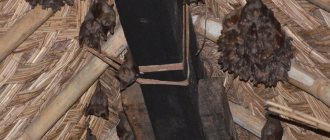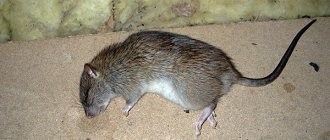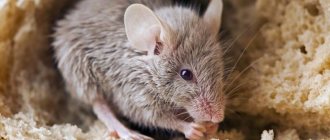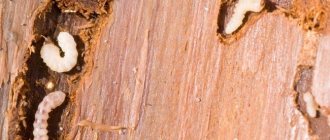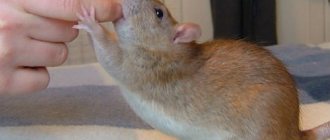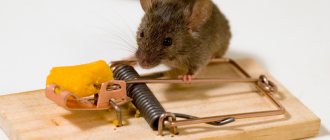It would seem that those who have their own house on the ground work in the summer and only rest in the winter. However, you should never let down your guard. From the beginning of cold weather, you need to make sure that mice do not get into the house and important outbuildings, do not spoil the insulation, do not get to food supplies, or chew through wires. Let's talk about how to protect ourselves from rodents or how to discourage their interest in our homes. After all, it is known that there are building materials that are more or less interesting for mice, which can be selected taking into account this problem; there are also effective ways to combat rodents.
Causes of rodents
Mice sneak into a frame house for several logical reasons. First of all, this is a search for food, which is always available in residential buildings. They are especially attracted by the presence of large reserves of cereals. There is also a high probability of their appearance in winter for the purpose of shelter from the cold. In places where winters are quite cold, this is even more true.
Frame houses are not a particular obstacle to the penetration of rats and mice. When constructing a building, it is very difficult to avoid gaps in the floor or at the joints. The partitions here are often hollow, and a drywall bug is unlikely to keep mice out and prevent them from getting inside. In a frame house, when lathing, empty spaces are filled with insulation. Mice easily gnaw through them and make nests there. This is especially true when using low-quality material and improper installation.
How to protect your garden from rodents?
- Rodents cause the greatest damage to young, succulent, but still weak plants and their shoots in early spring. However, stocks are also actively collected in the fall. Rats are especially good at this. How much damage mice and rats will do to a garden depends on how much the rodent has stored for winter, how easily it can access plants, and how severe the winter will be.
- If, in preparation for winter, plants are covered with straw, hay or leaves, branches of coniferous trees - spruce, pine or juniper - are also laid in the middle. The needles will prick and the rodent will not be happy to build a nest or dig a hole there.
- Plant plants that have an unpleasant rodent odor. You can also plant onions Fritillaria imperialis, Mentha piperita, Verbascum and Cynoglossum, Sambucus nigra or Sambucus nigra. Of the summer flowers, mice and rats dislike velvet (marigolds) the most. Having freed the beds, old velvet hopes can be broken, buried or buried in the soil. Leaves and branches of other plants are mentioned in the same way.
- Ultrasonic repellents for gardening and vegetable gardens work effectively. Rodents usually do not stay in places where sound travels. However, it has been noted that sometimes the rodent moves to another corner of the garden, where the ultrasound is not heard and continues to cause damage.
- Natural remedies that mice and rats don't like will also be helpful. Pieces of beaver glands, chopped garlic, sprinkled with cayenne pepper, or dry black tea bags can be crushed in pits or caves. Similarly, rodent moss is made of ammonia and carbide aroma, which upon contact with water releases a caustic substance (acetylene) and is harmful to rodents.
Simplifying your life with homemade rat traps from scrap materials
It is quite possible to make a trap for rodents with your own hands from available materials. This allows you to get rid of rats and mice with minimal financial outlay, and often homemade traps work no worse than industrial options.
For example, at home it is very easy to make a very effective live trap from a deep container, a piece of thick wire and two or three strips. The task here is to make a tipping bridge from wire and one plank. A bait is placed on the edge of the bridge, it is installed on the container, and an improvised ladder is made to the entire structure, along which the animal can climb to the edge of the container. As soon as he tries to get closer to the bait, the bridge overturns and the rat falls into the container.
It is useful to do two non-obvious things in such a design:
- Pour water into the container so that the rat cannot push off from the bottom and jump out;
- Attach the bait to the bridge - after the rat falls into the container, the structure will return to its original position and will be able to catch more than one rat.
There are many options for implementing such a mechanism: a rat can fall from a table after climbing into a cardboard house with bait on the edge; or above a container (barrel, bucket) you can place a bottle rotating on a metal rod, coated with bait, so that it rotates under the weight of the animal and “drops” it into the container.
Below in the video you can see a clear example of how such a trap works:
https://youtube.com/watch?v=pyLh1WyvpXA
There are other options for simple homemade traps that allow you to get rid of rats in a private home without using any other means. Traps can also be made lethal, so that the rat does not have to be killed personally or shaken out alive.
Such traps are used in the same way as store-bought ones, and their main advantages are the ability to be manufactured at home and, in most cases, increased safety of use (which, however, depends on the design).
To summarize: traps are well suited for the safe, methodical extermination of rats in the house, and if you use them in conjunction with bait stations, you can catch rodents in almost any room. Traps are probably not suitable in cases where a large number of rats or mice need to be destroyed as quickly as possible, all at once.
In this case, rodent poisons can come to the rescue.
Where do they come from?
If there are mice in your house or apartment, you need to get rid of them as soon as possible, before their population becomes critical.
If the routes to their entry are not blocked in time, large-scale actions will be required to destroy all rodents.
If we talk about urban areas, then mice most often enter the apartment from basements and garbage chutes. If the house is old, it probably has damage, crevices, and cracks. A tiny hole is enough for mice to crawl from one room to another.
Since rodents love to eat grains, nuts, sweets, and other edibles, they can often be found in the kitchen. They make their way there through the ventilation shaft and holes for sewer pipes.
Since animals love warmth and dampness, in private houses they can sneak into rooms through the cellar, through cracks in wooden floors. If there are often bread crumbs or other leftover food left on the kitchen floor, mice smell the smell and go towards it, dragging their relatives with them.
Therefore, when thinking about why there are mice in the house, you need to reconsider your own behavior. Perhaps, by being more tidy in their home, rodents will not bother their owners.
What are the dangers of a mouse infestation?
So, let's see what difficulties ordinary house mice can create under the floor:
- Constant noise at night.
- Gnawed cables, wires and pipes made from certain materials.
- Insulation materials turned to dust.
- A specific and not very pleasant “mouse” smell in the house.
- Found mouse waste in the morning wherever possible.
- Danger of contracting rodent-borne diseases.
And also such unpleasant phenomena as a dead mouse under the floor, which is not easy to find and pull out.
Now imagine that in a year a female gives birth to up to 7 mice in each of 10 annual litters. Those. in 12 months there will already be 60-70 new rodents in your house! And each mouse matures within just three months, and also begins to reproduce. At the same time, mice are fast animals: they can reach speeds of up to 12 km/h, jump up to 75 cm in length, and up to 40 cm in height. Just don’t let this problem take its course - they will eat the house too.
Signs that there are mice in the house
The first sign that there is a mouse in the house is the characteristic squeaking sounds coming from under the floors, behind the walls. You can hear the grinding of claws and teeth on surfaces, which is best heard at night.
You can also notice damaged food containers, gnawed items, parquet flooring, cabinet doors, and other furniture items. If this type of damage is detected, you should carefully inspect the floors (especially around the baseboards) and walls.
Signs of the presence of parasites at home are:
- extraneous rustling sounds at night;
- fussing under the wooden floors, in the space between the walls;
- bite marks on food products, bags of cereals;
- holes in the floor, baseboards;
- presence of mouse excrement;
- visualization of animals.
The passages created by mice can be so small that it is initially impossible to believe that someone larger than a cockroach could fit into this hole. However, this may turn out to be a mouse passage.
Advantages and disadvantages
A high-quality frame house should be:
- reliable, able to withstand any load;
- resistant to earthquakes and other natural disasters;
- environmentally friendly, not harmful to the health of those who live in it;
- comfortable in temperature (cool in summer, warm in winter).
The undeniable advantages include the fact that it is built quite quickly
, that is, its cost is reduced and the owners can move into their home earlier. Frame-panel houses can be used in places with temperatures from -60 to +60 °C. They are durable - they can be used for about 100 years. Such houses are not afraid of hurricane winds, earthquakes, or snowfalls.
All costs for the construction of the building are easily recouped - the panels include insulation. This allows you to save on heating the room in the cold season.
Also, frame houses weigh little, which reduces the load on the foundation and soil - this also contributes to the durability of the structure. Such a building can be erected at any time of the year.
, because there are no so-called “wet” construction processes. Smooth surfaces also make it possible to significantly simplify finishing and bring various architectural ideas of the customer to life.
This little flaw
Frame houses would be ideal if not for one small but very unpleasant drawback - rodents
. These small animals dig holes for themselves in glass wool and expanded clay, and prevent the owners of the house from sleeping peacefully. Mice can live peacefully within the walls of a frame building, and the owners will rack their brains for a long time about how to drive away the uninvited guests.
The threat of mouse infestation is especially relevant for buildings in the construction of which cheap polystyrene foam was used as insulation.
.
How not to catch a mouse in the house?
It is best to place a rodent bait or trap against a wall or behind furniture located a few inches from the wall. Rats and mice have poor eyesight, so they use smell and touch to move. It is because of poor eyesight that these rodents walk indoors along the walls, which serve as the safest landmark.
Then there is a high probability that the rodent will find the bait and will feel more secure. One of the most common mistakes is placing poisoned food or traps in the middle of the room. Fearing getting lost, the rodent rarely appears in the middle of the room. In most cases, this only happens when the mouse or rat has already been poisoned. Also in the garden, mouse trapping will be more successful if the trap, cage or bait is placed in a less exposed area, closer to a fence or at the exit of burrows.
Fighting methods
If rodents were able to enter the room, you need to think about how to get rid of mice in a frame house. There are many ways. It is necessary to take into account the number of pests and the structural features of the frame house.
Ways to control rodents
Using poison is not the best option, since the mouse can die in the wall, and the cadaverous smell will spread throughout the house. Even if a product with a mummifying effect is used, an unpleasant odor is present, although not so strong. Mice in a frame house must either be caught or driven away.
You can catch a mouse using traps, store-bought traps, or you can make mousetraps with your own hands.
- One of the options for making your own is a plastic bottle. Cut off the neck. Mouse bait is placed inside and the walls are coated with sunflower oil. Place the neck inside the bottle and secure it with tape. Leave the trap in any room. The mouse easily climbs into the bottle through the narrow neck, but the slippery walls prevent it from getting out.
- Water is poured into a bucket, husks, straw, leaves are crushed on top, a spoonful of vegetable oil is poured, seeds and grain are sprinkled. A ladder - a stick - is placed next to the bucket. The mouse crawls for food, falls into the water, and drowns. The top layer is restored, and another rodent may fall into the trap.
- A sticky trap is one of the simplest, most convenient ways to catch rodents in the country. Making a trap yourself is not difficult. Rodent repellent glue is applied to plywood, thick cardboard, and oilcloth, and the base is fixed to the floor so that the mouse does not drag the trap with it. The bait is placed in the center. The rodent sticks its paw, tries to get out, but falls even further into the trap. Several pests can be caught at once. But the biggest drawback is the cries of animals, which you don’t want to listen to in a residential building.
Repellent
You can drive mice out of the frame using an unpleasant odor or sound.
- Bunches of peppermint, chamomile, tansy, and wormwood are stuffed into holes along the walls. Such plants do not allow the mouse family to live; you can use mouse grass for prevention.
- The floors are washed every evening with a solution of vinegar and ammonia. Concentrated preparations are left in a saucer on the floor.
- You can wash the floor with water with the addition of essential oils of mint, lemon balm, and citrus. Rodents do not like these smells. If you were able to start in a frame house, you need to prepare for daily evening procedures with washing the floors.
The modern repellent method involves the use of a professional device - an ultrasonic rodent repeller. The market can offer products from domestic and foreign manufacturers. Based on customer reviews, it is difficult to understand whether the device works or not; there are conflicting opinions. There are many positive reviews about the effective devices Typhoon and Clean House.
You won’t have to fight mice every season if you take drastic measures. Change the insulation, install metal mesh. If you have already received a frame house with rodents, you must first get rid of the mice in it, then begin arranging the mansion.
How to deal with rodents in your home
You need to fight mice as soon as traces of their activity are noticed. Do not forget that rodents are extremely prolific, and if time is missed, the colony will grow to enormous sizes.
General rules
Recommendations for rodent control:
The first rule is to seal all visible cracks in the floor and roof. The mice will gnaw through them again if you don’t fight them, but this measure will stop the rodent invasion for a short time. It is necessary to shake out all the things in closets and pantries and wash them using peppermint oil - rodents do not tolerate this smell and will not make nests in clothes. Wash all surfaces with vinegar or wormwood oil. Place supplies out of reach, pour all cereals and dry foods into tightly sealed glass or metal jars. Close the trash can tightly, take it out daily and wash the bin itself with vinegar or chlorine. If possible, have a cat in the house.
Traps
The simplest means of dealing with mice is standard traps or mousetraps. They need to be placed throughout the house - in places where excrement has been noticed. As bait, it is best to use pieces of bread soaked in vegetable or sesame oil - this smell drives mice crazy, they like it so much.
Note! The problem with mousetraps is that they are only suitable for fighting single individuals. If the population is large, then only a couple of mice will fall into the trap, the rest will begin to avoid them.
Lures
Glue baits are very effective. You can simply use mouse glue and make the bait yourself, or you can buy a ready-made design in a special store.
In the finished version, glue is applied to the entire area of the cardboard, which can be folded into a tube and left in places where pests can pass. The bait itself is placed in the middle of the cardboard - a nut or grain mixture soaked in oil.
Article on the topic: Is it possible to have a wooden house covered with siding?
Making your own bait:
You need to take a thick cardboard or plastic board, apply a thin layer of glue and put a piece of bread, grains or seeds in the middle. The mouse, attracted by the smell of the bait, gets caught in the glue and cannot get out. If there are a lot of rodents in the house, then by morning you can find up to five firmly stuck rodents on one bait.
Poison
It is better to buy the poison ready-made; it is sold in the garden departments of most hardware stores. This is the most ineffective means of controlling rodents. The mice are sent to sample the food of the weakest and sickest members of the colony. If they die, then the rodents will no longer touch the poison.
There are special products that kill mice only after three days. They can get rid of an entire colony of mice, but the dead rodents begin to decompose in holes, from where they are difficult to get out, and the disgusting smell can linger in the house for many weeks. Therefore, poisoning mice using this method can only be done in summer cottages before the winter period.
Repellers
Special ultrasonic devices (Grad, ElectroKot) are good at getting rid of mice - they affect the nervous system of pests, driving them crazy. The sounds produced by repellers are unbearable for rodents, but are absolutely not perceived by humans or pets.
Repellers against mice - voles - are very effective; the device can be stuck into the ground, and within a couple of weeks there will be no mice left on the site.
When buying a device, it makes sense to check its range - if it is small, then you will need to buy several of them to install in each room.
Find out how and how to clean an enamel pan from burnt jam from this article.
Go to the address and read about how to get rid of ants in your home using improvised means.
Article on the topic: How to level joists in a wooden house
Folk remedies
If you can’t buy traps or poison, you can make them yourself.
Gypsum bait is very effective. Gypsum or concrete is mixed with a grain mixture previously moistened with vegetable oil. Bowls of water are placed next to the “delicacy”.
A mouse that eats such a meal will permanently cement its intestines and die. Not very humane, but very effective.
Rodents cannot tolerate strong odors:
mint, lemon balm, chamomile, wormwood.
You can spread these herbs in places where mice live, you can wash floors and all surfaces with the addition of oils from these herbs.
The smell of vinegar and chlorine repels rodents well. These odors will forever remove the very “aroma” of the vital activity of mice.
Insulation and rodents is there a solution?
Let's be clear right away - most modern floor insulation materials really don't eat mice, but at the same time they live quietly in them. And they also build nests in soft ones.
Fun fact: Mice's teeth grow throughout their lives. Moreover, if the mouse does not constantly chew something, then these teeth will grow into its upper jaw. Therefore, gnawing is a daily need for this animal. And the mouse can even sharpen concrete walls.
Oddly enough, mice are especially often found in polystyrene foam. Moreover, they gnaw on it - but not with the goal of getting enough, but with the goal of building comfortable nests in it. And therefore, manufacturers recommend insulating walls and floors with ecowool, which is looser and creates an antiseptic environment. But mice also gnaw on it, although not so willingly.
After all, as practice shows, mice can live under the floor in ecowool, foam plastic, and almost any other insulation. Even in glass wool! However, it is worth noting that it is very difficult, almost impossible, for a mouse to chew through ordinary plywood and OSB boards. All because of the structural features of her teeth. Like slabs that have a layered structure with wood chips directed in different directions.
The secret of the survival of these animals in any conditions is their extreme unpretentiousness. That’s why they gnaw holes for themselves in anything, in a word.
Why are they dangerous?
When thinking about how mice are dangerous for humans, it is worth noting that they harm not only household devices, furniture, books, and other home furnishings. These animals become carriers of dangerous diseases.
With their paws and saliva, they leave dangerous bacteria containing toxic substances on food products, which can cause serious diseases in humans.
Frame house protection
In order to prevent rodents from settling in a new building, you should carefully consider how to protect the house from mice during construction. The following techniques can be used as preventive measures against pests:
- It is recommended to use ecowool as floor insulation on the first floor. It will protect the house from the appearance of fungus, mold, and various insects. The material is 80% recycled cellulose, and 20% is a mixture of boric acid and borax. The composition is an excellent antiseptic for wood and will protect the mansion from mice and other pests.
- Treat building materials with borax or lime solution.
- you can use ash, tobacco dust, wormwood or peppermint, the smell of which rodents cannot stand, and also fill the interior partitions with slag.
- If the soil characteristics allow, replace the pile or strip foundation with a reinforced concrete slab, which mice will not be able to chew through and will not penetrate into the frame house. The use of monolithic structures will provide reliable protection for your home.
- Using a special fine-mesh metal mesh that will protect the building from rodents.
All these techniques will protect the structure from mouse attack.
Application of metal mesh
In addition, during the construction phase or after the construction of the structure, a metal mesh is used to ensure its safety. It has a number of positive properties:
- ease of use;
- maximum protection against various rodents;
- environmental safety;
- accessibility to consumers;
- ability to maintain its characteristics over a wide temperature range.
To ensure effective protection, it is necessary to choose the right material. The thickness of the wire from which the mesh is made must be at least 2 mm, and the parameters of the cells no more than 5x5 mm, otherwise mice will gnaw through it or simply crawl into the existing holes.
The mouse net is laid along the subfloor, in this case the insulation is spread directly on it. Or they cover the base of the house with it, since mice can be found under the floor inside the space that is formed as a result of building a house on stilts. The height of the protective coating laid under the plinth casing must be at least a meter. Before insulating and finishing the house, it is advisable to cover all corners of the building with galvanized mesh.
A built frame house can be protected from mice. To do this, you should bury a mesh fence along the foundation to a depth of at least 0.8 m, and if there are rodent holes, then the laying of the protective structure should be deeper than mouse passages.
The effectiveness of this method of protecting a frame house from mice is evidenced by numerous reviews from the owners of such cottages posted on the website.
Floor
Screw stilt houses, like other frame structures, require effective protection of the floor, which is the most likely place for mice to enter the house. When arranging it, you should use both metal mesh and other means. Expanded clay will be an effective method of protecting flooring:
- when laying the subfloor, it is spread onto the ground in a layer of at least 0.3 m;
- the material is covered with a polyethylene film, on top of which OSB-3 boards are placed in two rows;
- then the final layer of expanded clay is laid, crowning the structure of the “black” floor, completely protected from mice.
The reliability of such an “expanded clay lock” is enhanced by impregnation of boric acid and synthetic wax, which is applied to the slabs.
Insulation materials
Appropriate insulation can act as protection against mice and rats. Quite often, to insulate a frame house from the inside, owners use cheap thermal insulation material - polystyrene foam. Mice can gnaw it and freely settle in the room. Experts strongly recommend not saving and using an expensive insulation option that effectively protects against rodents - ecowool. Ecological material will not only repel rodents, but will also create an antiseptic environment that prevents the appearance of mold and other negative phenomena. This insulation has good heat and sound insulation characteristics.
Mice and drywall
Often mice settle behind drywall, and getting rid of these residents becomes problematic. The building material is too thin, pliable and it is easy for rodents to chew through it, no matter how carefully the cracks and holes are sealed.
What to do? In houses where gray bandits become frequent guests, either do not use drywall at all, or additionally reinforce it on the outside with a metal mesh with small cells. It is not necessary to cover the entire height of the walls; it will be enough to attach it at a distance of 30-40 cm from the floor. The mesh holes should be minimal - after all, rodents are able to crawl into holes the size of a pencil .
Builders also advise laying various materials that are dangerous or unattractive to mice in the space between the drywall and the main wall:
- Broken glass along the entire perimeter of the wall.
- The glass wool layer is a prickly material and animals do not like to come into contact with it, although home owners claim the opposite.
- Instead of glass wool, you can use ecowool. The fact is that in its composition, in addition to environmental cellulose, there is orthoboric acid. The substance causes severe thirst in rodents, so mice, even if they settle in this heat-insulating material, will eventually retreat anyway, unable to withstand the “drought.”
- Well, the last alternative to laying in drywall is foam glass or expanded clay: according to manufacturers, their animals are not particularly fond of them.
The folk method, which also has a right to exist, is quite simple and unpretentious: during installation work on the construction of the structure, burdock or blackroot seeds are placed in the pier. The “nuts” are not only prickly, but also tenacious - they stick tightly to the animal’s fur, interfering with its movement. As a result, mice either die of hunger or do not penetrate such walls at all.
Instead of poisonous plants, you can add a layer of boronic acid: again, this is added during the repair process, because after that it will be difficult to do so.
If the pests do settle down behind the drywall, they work according to the scheme described above: they lure them out, destroy them, and close up the holes.
How to escape from mice
Ubiquitous animals can appear anywhere - in the basement, crawl space, attic, kitchen and living rooms. Owners of apartments in multi-storey concrete buildings are extremely surprised to discover that, for example, a mouse has settled in the bathroom, although the apartment is located on the 5th or 7th floor. But for her, climbing sewer pipes or ventilation shafts is actually not that difficult. What then can we say about wooden low-rise buildings? For rodents, this is simply paradise.
The activity of mice regarding their settlement for the winter begins closer to autumn. They gnaw holes in the wall, which are not so easy to detect, get inside and nest where it is warmer and more nourishing. Wherein:
- destroy food supplies stored in the house;
- leave waste of their life;
- carry dangerous infectious diseases into the home;
- undermine wood;
- damage furniture;
- chew through wiring;
- scare household members with their unexpected appearance;
- crawl into small cracks that are smaller than the thickness of their body;
- fill the space with unpleasant odors.
In fact, mice can nest anywhere - in insulation and polystyrene foam, in sawdust and underground bedding. They should not be left alone, as they multiply very quickly, and thanks to their natural instincts and herd life, they easily gain experience in how to avoid the traps placed in their path. There are often cases when overly smart representatives of gray pests manage to eat the bait in a mousetrap without getting caught in it.
The fight against rodents should begin at the stage of construction of a wooden house. For this purpose, the following is selected as insulation:
- ecowool - contains an antiseptic and a component that causes suffocation and a strong feeling of thirst in mice, but the material is completely harmless to humans;
- expanded clay - a 10-centimeter layer directly under the floor is enough to protect wooden beams from rodents.
Laying fine metal mesh in the crawl space and on the surface of the plinth will help create a barrier that will be difficult for pests to overcome. Ash scattered at the intended entry points of mice, which irritates their mucous membrane, also helps. When moving into a ready-made house, it would be a good idea to get a cat. Even if she does not turn out to be a diligent hunter, she will still be able to scare away unexpected gray guests with her smell and menacing appearance.
If mice appear in an already residential building, you will first need to put it in appropriate order:
- seal cracks and discovered holes, first filling them with broken glass;
- place stocks of cereals, flour and sugar in metal or glass containers with lids;
- carefully hide leftover food;
- remove debris from old clothes and other rubbish;
- remove from the house containers that have not been used for years, etc.
Only after this can we hope that more effective protection of a wooden house from mice and insects will bear fruit. Some remedies act instantly, others gradually, and others turn out to be inappropriate in the current situation, and therefore completely useless. There are modern methods of controlling rodents, but many prefer to use old-fashioned methods, which, in the end, turn out to be no less effective.
We list the most popular options for protection against rodents:
traditional mousetraps - often animals simply do not pay attention to them, since this danger is already in their genes; poisoned baits are dangerous for pets; ultrasonic devices - capable of scaring away mice from an area of up to 100 square meters, and not just from a small house; special means - it is recommended to use outside the house, since rodents before dying can hide in a hard-to-reach place that cannot be detected, but the unpleasant odor will remain in the room for a long time; sharp-smelling substances such as naphthalene or kerosene are unlikely to be suitable for living rooms, so they are used in utility buildings; ash – if it gets on the paws, it causes severe discomfort; lime mixed with sugar and a container filled with water placed nearby - effective, but controversial from a humane point of view.
Despite the fact that the fight will be against pests and troublemakers, you should choose a more gentle method of getting rid of them. It is best to use, of course, ultrasonic repellers. And although they are not cheap, they can be used for quite a long time, moving them from home to a barn, summer kitchen, bathhouse, etc.
Traditional methods of protecting floors from mice
If you still have mice under the floor, you can also contact a professional service. They carry out a special treatment that allows you to forget about rodents for a whole year. This is the simplest, although not the best option. There are other traditional methods.
Frightening aromas: from mint to burnt wool
When laying the floor, add ash, slag, tobacco dust, dry wormwood or mint to the insulation - mice really don’t like all of this. Some also add red hot pepper or a lot of broken glass.
Moreover, the smell of dried mint has a suffocating effect on the mouse. While you are away from the house, you can even hang this plant in different corners - this really helps.
Underground mice do not like not only mint, but in general anything that smells strongly and unpleasantly. The aroma of burnt wool is especially disgusting for them - some even use it to fumigate the room, and throw the burnt remains under the floorboards. Mice do not like this smell and usually retreat from such places.
Also, when building a house from blocks, builders often treat them with borax or lime solutions. Everything is the same.
Traps: modern and homemade
Glue traps are the most popular today. So far, the best reviews are for ALT glue, which is not expensive and quite sticky. It needs to be applied to a piece of plywood in the form of a circle, and a drop should be left in the very center. We put bait on it, and even if the mouse touches the glue with just the tip of its tail, it won’t go anywhere.
Note that wire spring traps are least suitable for a private home in the fight against mice - if there are already a lot of holes and passages near the house, you will then have to dig out these pieces of iron on the site for a long time.
But, if the rodents have already multiplied, such a fight against them can be exhausting.
Pesticides: the main thing is not to poison the cat!
But pesticides have a significant disadvantage: firstly, they can accidentally poison a pet, and secondly, no matter how the sellers claim that mouse carcasses quickly mummify and do not emit odors, in fact they decompose for quite a long time in hard-to-reach places, and it is impossible to live in the house during this period.
Therefore, if you use pesticides, then scatter them under the floor only in early autumn - when rodents gather to stay.
Ultrasonic repellers: both mice and cats
This is a new word in the fight against mice under the floor. After all, there are no barriers to ultrasound. So, they are small devices that, when turned on, produce a sound of a frequency inaudible to humans, but for rodents it is quite unpleasant and affects the nervous system.
When choosing such a device, you should carefully choose the manufacturer and not save money, otherwise the cat may run away from the house. And ultrasonic repellers are not always safe for people. We can say that this issue has not been fully studied, and yet some part of the population hears a thin squeak when the device is turned on, which a priori should not be heard. Therefore, this method is more suitable for a bathhouse or a country house where you do not come too often. When we left, we turned on the device, when we arrived, we turned it off for a while.
The range of modern repellers themselves is very diverse - and among such devices there are many that have a noticeable effect, but do not give 100% results.
Thus, the most powerful repeller to date is “Spectrum”, which covers up to 300 square meters. For an underground space, this is the best choice: it works without interruption for several years, and can withstand high humidity in the basement and voltage in the electrical network. If the electricity is turned off, then the device will turn on itself, and therefore it is convenient to install it in a country house or bathhouse, where you are absent for months. But the most important thing to do is to close all the cracks in the house and completely isolate the food. After all, even nylon lids on jars can easily be chewed by mice - more reliable protection is needed here.
Also, ordinary people recognize such repellers as “Typhoon”, Weitech WK-0300, WK-0600 CIX, “Grad A-500” and “GRAD A-1000 PRO” as quite effective. They have a fairly powerful and expensive base, a wide radiation pattern and a constantly changing ultrasound frequency, which ensures that rodents do not get used to it. Pestchaser 360 M+, Pestchaser 360 and “CHISTON-2 360” are already less popular.
And the cheapest repellers have weaker technical components and low power. Rodents get used to them quickly and on the very first day. These brands are Weitech WK-0220, Pestchaser LS-968, Pestchaser AC/DC and Weitech WK-0240.
If you decide to fight mice under the floor in this way, be sure to study the certificates included with your purchase. Otherwise you may end up buying a fake.
Predators - biological weapons
So, the most terrible animals for mice are cats and ferrets. Moreover, the latter are much more experienced and dexterous in this regard! Get such a pet - you will be surprised.
As for cats, not all breeds of this family like to catch mice. And cats are completely lazy. But rodents are more afraid not so much of the rare chance of getting caught as of the smell of the predator itself. That’s why some craftsmen scatter cat hair under the floor – and this is an excellent and effective method.
You will also be interested to know that a cat is not just a predator that likes to eat mice. This is a real biological weapon against the latter. So, in cat excrement there are special substances that act on the consciousness of rodents, and they already behave more fearlessly - and are easier to get caught (which is why cat owners who are not very hygienic often, having lost the same sense of danger, end up in accidents more often than others - there are such research).
A breed of dog such as the American Staff Terrier is also bred in America. These are real rat catchers, and they are bred specifically for farmland instead of cats. They are also great at catching mice, although they don’t eat them. Speaking of breeds: the more decorative a cat is, the less prone it is to natural hunting, and therefore it is better to give preference to an ordinary yard Murka. And finally, it is worth noting an interesting fact: what mice are most afraid of is not cats, but rats. And in the house where there is one rat, there are usually no mice.
What is the mesh for?
It serves as a very good barrier to rats, mice, hares, and other rodents that can easily get into your home and gnaw on various seedlings. They pose a particular danger to young trees, which may even die after being attacked by rodents.
Also, if you are planning to build a house and do not want to subsequently try to get rid of mice under the floor, you need to protect yourself in advance and install a protective mesh.
City buildings should also not be ignored.
It is also recommended to install protective nets on basement windows, through which mice and rats can easily crawl into the house and cause damage to property.
It is equally possible to use nets to protect crops during winter and spring storage in vegetable pits.
What can you do to prevent mice from living in your home?
To prevent mice or rats from staying near your home and entering it at convenient times, the most important thing is to avoid places where they might nest, gather supplies, hide, raise young, and hunt unnoticed. In the garden, mice and rats hide on the lawn, in ditches, in caves and bushes dug into the soil, in piles of leaves and hay.
Closer to home, mice can take up residence in rubble piles, saunas, sheds, stacks, under dog houses or on wooden decks. They will always try to stay where food is easily available. When a dog falls asleep but still has something left in his bowl, mice and rats eat it right away.
Rodents usually enter premises through open doors or windows, damaged sewer pipes, large ventilation hatches, cracks and holes in walls.
Rats and mice are usually located in basements and on the first floors of buildings. However, if the wall of the house is rough or covered with vines, rodents can also climb into the attic or higher floors. In addition, rats are not afraid to jump from heights of more than one meter.
How to prevent mice from getting into your home:
- If there are no dense plants around the house, and there is a blind area or tiles around the house at least a couple of meters wide, it will be more difficult for rodents to get into the house, because they will have nowhere to hide.
- If the house is guarded by a dog, or you have an outdoor cat, mice and rats will feel threatened when crossing open spaces.
- The dog should eat as much food in the bowl as he ate at one time, but leave leftover food in the bowl.
- Openings through which uninvited guests can enter the premises must be promptly removed.
- If food or debris is found in the food, it should be discarded and the surface where the rodent lives should be thoroughly cleaned.
Effective methods of protecting a frame house from rodents
Measures to protect against various rodents entering your home may vary. The most effective measures to prevent rodents should be taken before building a house.
Exist:
- active (various poisons, mousetraps, etc.);
- passive methods (grids, insulation, use of special solutions).
Passive methods of protection
Passive methods of protecting frame houses are used before and during construction, which will help avoid rodent infestations in the future.
The mesh is a steel structure made of wire and consisting of additional small cells. It is one of the most effective methods of passive protection against pest penetration. The wire should in no case be thin, at least 2 millimeters thick
This point is worth paying special attention to, since rats can easily gnaw through the thin structure.
Since the design of the house contains thermal insulation blocks, which are a very attractive refuge for rodents, special attention should be paid to this point. Thermal insulation blocks must be coated with a special solution of lime and borax, and then the blocks must be rolled in with universal insulation - ecowool
The coating should be very dense.
The best way to protect a frame house from rodents is to install a reinforced concrete monolithic slab at the base of the house. The slab must be filled with expanded clay. Thanks to this, rodents will not be able to enter the house.
Active methods of protection
If the house has already been built, and the protection installation technologies did not bring any effect, or were not designed correctly, then it is necessary to resort to active protection methods.
Poisons and poisons
There are many different chemicals available to kill rodents, but when used, there is a risk of poisoning pets or children. Therefore, when using various poisons, you should be very careful.
Poisons such as rat poison, poison, and various powders are used to suffocate rats and mice.
Mousetraps
A mousetrap is a simple method that has been proven over the years. There are different types of mousetraps: mechanical and humane mousetraps that do not kill rodents.
Repellers
Installing ultrasonic and other repellers is the most humane way to get rid of rodents, as well as one of the most effective.
They are an electronic structure that emits ultrasonic or electromagnetic waves in various frequency ranges. This sound is extremely unpleasant for rats, mice and moles, as it has a depressing effect on the nervous system of rodents, but the sound does not cause any inconvenience to humans. Currently, repellers such as, are available in stores.
*The numbers in the names of the repellers indicate the area of effect in square meters!
It is also an effective means of catching rodents. Once on the surface of the trap, rodents cannot move.
Materials that are sometimes damaged by rodents
Mineral wool - sometimes damaged by rodents, but positions itself as a material in which rodents do not live.
The fibers are rarely damaged, but mice can build nests in them. When using this material, it is important to lay the mineral wool so that it does not deform.
Extruded polystyrene foam is a fairly dense raw material, so rodents rarely penetrate it, and yet such cases do occur. Unfortunately, this material will not be a barrier for rats.
Polyurethane foam is a dense material that is rarely damaged by rodents. However, if constant protection is not provided, over time it becomes less dense, begins to deteriorate and can easily be chewed by pests.
To ensure that this moment does not come so quickly, you need to think about reliable protection of the foam from moisture and ultraviolet radiation. This can be achieved through coloring.
Glass wool practically keeps mice out, and even a thin layer is enough. This is achieved due to the traumatic composition. However, over time, its properties may become less dangerous for rodents.
Article on the topic: How to calculate the wooden frame of a house
Ways to protect fruit trees
In winter, the wood of fruit trees is a real treat not only for mice, but also for hares and other rodents. The first thing you need to do if at least one side of your plot overlooks a forest or field is to fence off your own territory with a high, solid fence, installing it on a concrete base or digging it into the ground at least 30 cm.
Fruit tree wood is a treat for mice in winter
The following methods will help protect trees from mice in winter:
- When preparing a tree for winter, the trunk is wrapped in several layers of covering material, burlap, and nylon tights. Place branches of any coniferous tree between them, placing their needles down. The best option is spruce; its needles are short, prickly, and stick out in different directions. Cover the tree trunk circle with spruce branches. The needles prick the sensitive noses of rodents; they do not touch the tree. The spruce branches do not interfere with the aeration process.
- Wrap the trunk with roofing felt so that it is not completely adjacent to the tree. In winter, it will protect the tree not only from rodents, but also from sunburn. But the roofing material practically does not allow air to pass through, so the cover must be removed in time, avoiding the root collar becoming warm. Mice often make digs, so the roofing material needs to be dug into the ground at least 15–20 cm.
- Fence trees with fine mesh plastic or metal mesh. It also needs to be dug into the ground. Metal is simply too much for mice, and they really don’t like the specific taste of plastic.
- In preparation for winter, whitewash the trunk and the lower third of the skeletal branches. The composition based on slaked lime is quite caustic, mice do not like it. To enhance the effect, manufacturers add special substances that repel rodents to store-bought whitewash; to homemade whitewash, they add shavings of tar soap and zinc oxide (zinc compounds are the basis of many poisons for rodents).
- If you have old buckets and large pots without a bottom, put them on young seedlings, digging them 15–20 cm into the ground. Such a barrier is impenetrable for mice, but they sometimes climb over it from above.
The tree trunks of fruit trees are often mulched. In general, this is a very useful agrotechnical event. But do not choose straw as mulch - mice often live in it.
Video: how to protect a fruit tree from rodents
It is impossible to completely protect your own country house and garden from mice in winter. But it is quite possible to minimize the damage if you take care of the necessary prevention in advance. There are many ways to fight and repel mice - these include folk remedies, chemicals, and special devices.
What harm do rodents cause?
Mice, rats and other rodents can easily enter a frame house without certain protective measures. By doing this, they not only frighten the owners, who are afraid or disdain such guests, but also cause harm. Destruction can occur in any corner of the home. They chew through concrete or wooden floors, wiring, and a wide variety of objects in the house. Often pests destroy winter supplies or other food.
If mice settle in basements, where it is usually damp and dark, they will begin to actively reproduce. In this case, dealing with their huge number is even more difficult. The most dangerous thing is that rodents are carriers of dangerous infectious diseases, for example, cholera, various intestinal diseases, and leptospirosis. Therefore, it is necessary to get rid of them as soon as possible, and for this we will familiarize ourselves with the methods of dealing with mice.
How to get rid of insects
There are quite a lot of parasites inhabiting a wooden house. But the most dangerous to wood are bark beetles and wood borers, as well as termites and ants. All of them, to one degree or another, destroy natural material, turning it into dust over time.
It is imperative to combat insects by taking preventive measures, and, if necessary, solving the problem with drastic methods.
Pre-treatment of wooden elements with antiseptics is carried out during the woodworking process. Then the surfaces are impregnated during the construction of the wooden house. The applied compounds penetrate deeply into the structure of the material, creating a reliable protective layer. The surfaces are additionally painted with varnishes or paints, and over time the coating is renewed.
Antiseptic agents such as BIOREX, PINOTEKS, TIKKURILLA, etc., affect not only adults. Their larvae also disappear. To get rid of insect colonies already during the operation of the house, you will need to find out where the places where they accumulate are located. This will allow you to process contaminated wood more efficiently and efficiently. If significant defects are detected, it is recommended to remove the affected areas and replace them with new ones.
Frame houses have many advantages, but, alas, they all come with a significant drawback: such houses often harbor rodents. These seemingly harmless creatures can cause a lot of harm. For example, rats can chew through the wires that are equipped with equipment located in the house.
Tips and tricks
If mice have appeared in a private house once, they will visit it periodically; in winter, rodents will definitely make themselves known, as they will look for warm, secluded places with close access to food.
To get rid of such an invasion, you need to order treatment not only in the house, but also on the site, as well as outside it, it is advisable to order it together with your neighbors. Treatment against mice simultaneously in several areas will give a fairly high result in exterminating pests. At the same time, it is worth carrying out a similar treatment of the sheds, cellars, garages, and bathhouses available on the estate, where mice can settle.
True, difficulties may arise for owners of various livestock who decide to poison mice - it will be difficult to place chickens, goats, etc. somewhere. Cats and dogs that accidentally wander into treated buildings are in mortal danger. Therefore, when carrying out large-scale extermination of mice, it is worth thinking about the fate of domestic animals.
Prevention of appearance in private (wooden, brick and any other) houses
Mice settle not only where there are food bins. They may be attracted by a crumb dropped on the floor and not picked up, or a half-eaten piece of sausage left on the table. You need to strictly monitor such moments, constantly wiping the countertop, sweeping the floor, tightly closing the trash can, so as not to guess later how to remove the rodents. You should not leave food unattended - it should be kept in designated storage areas that are inaccessible to mice.
If pests appear in the house or area, measures should be taken immediately: seal the cracks through which they can penetrate, treat the perimeter of the premises with poison (if there are no pets or small children in the house), set mousetraps, use bait and repellers. It would be nice to find nests where females lay offspring in order to destroy their entire family at once.
